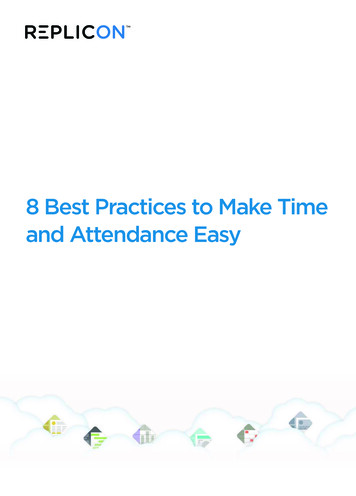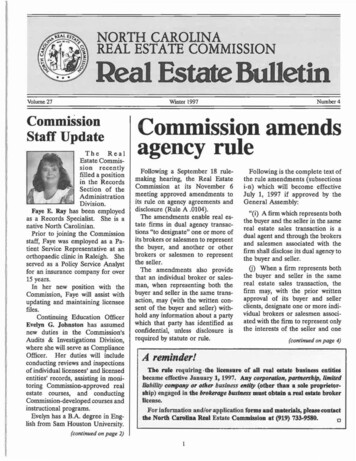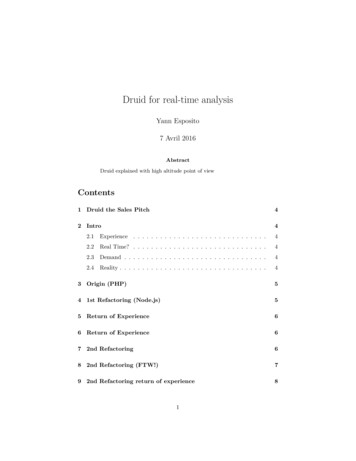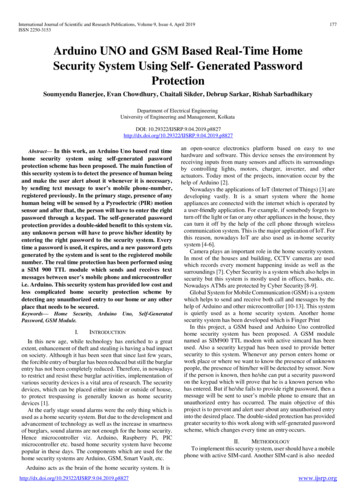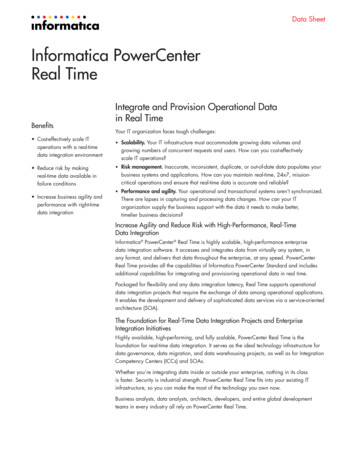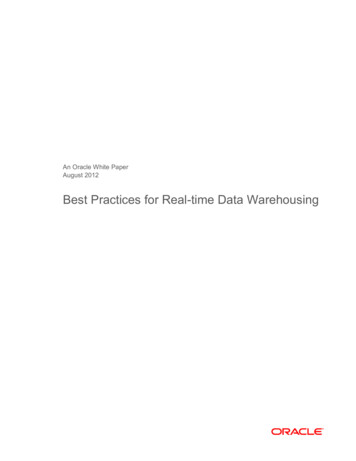
Transcription
An Oracle White PaperAugust 2012Best Practices for Real-time Data Warehousing
Best Practices for Real-time Data WarehousingExecutive OverviewToday’s integration project teams face the daunting challenge that, while data volumes areexponentially growing, the need for timely and accurate business intelligence is alsoconstantly increasing. Batches for data warehouse loads used to be scheduled daily to weekly;today’s businesses demand information that is as fresh as possible. The value of this realtime business data decreases as it gets older, latency of data integration is essential for thebusiness value of the data warehouse. At the same time the concept of “business hours” isvanishing for a global enterprise, as data warehouses are in use 24 hours a day, 365 days ayear. This means that the traditional nightly batch windows are becoming harder toaccommodate, and interrupting or slowing down sources is not acceptable at any time duringthe day. Finally, integration projects have to be completed in shorter release timeframes,while fully meeting functional, performance, and quality specifications on time and withinbudget. These processes must be maintainable over time, and the completed work should bereusable for further, more cohesive, integration initiatives.Conventional “Extract, Transform, Load” (ETL) tools closely intermix data transformationrules with integration process procedures, requiring the development of both datatransformations and data flow. Oracle Data Integrator (ODI) takes a different approach tointegration by clearly separating the declarative rules (the “what”) from the actualimplementation (the “how”). With ODI, declarative rules describing mappings andtransformations are defined graphically, through a drag-and-drop interface, and storedindependently from the implementation. ODI automatically generates the data flow, whichcan be fine-tuned if required. This innovative approach for declarative design has also beenapplied to ODI's framework for Changed Data Capture (CDC). ODI’s CDC moves onlychanged data to the target systems and can be integrated with Oracle GoldenGate, therebyenabling the kind of real time integration that businesses require.This technical brief describes several techniques available in ODI to adjust data latency fromscheduled batches to continuous real-time integration.1
Best Practices for Real-time Data WarehousingIntroductionThe conventional approach to data integration involves extracting all data from the sourcesystem and then integrating the entire set—possibly using an incremental strategy—in thetarget system. This approach, which is suitable in most cases, can be inefficient when theintegration process requires real-time data integration. In such situations, the amount of datainvolved makes data integration impossible in the given timeframes.Basic solutions, such as filtering records according to a timestamp column or “changed” flag,are possible, but they might require modifications in the applications. In addition, theyusually do not sufficiently ensure that all changes are taken into account.ODI’s Changed Data Capture identifies and captures data as it is being inserted, updated, ordeleted from datastores, and it makes the changed data available for integration processes.Real-Time Data Integration Use CasesIntegration teams require real-time data integration with low or no data latency for a numberof use cases. While this whitepaper focuses on data warehousing, it is useful to differentiatethe following areas:-Real-time data warehousingAggregation of analytical data in a data warehouse using continuous or near realtime loads.-Operational reporting and dashboardsSelection of operational data into a reporting database for BI tools and dashboards.-Query OffloadingReplication of high-cost or legacy OLTP servers to secondary systems to ease queryload.-High Availability / Disaster RecoveryDuplication of database systems in active-active or active-passive scenarios toimprove availability during outages.-Zero Downtime MigrationsAbility to synchronize data between old and new systems with potentially differenttechnologies to allow for switch-over and switch-back without downtime.-Data Federation / Data ServicesProvide virtual, canonical views of data distributed over several systems throughfederated queries over heterogeneous sources.2
Best Practices for Real-time Data WarehousingOracle has various solutions for different real-time data integration use cases. Queryoffloading, high availability/disaster recovery, and zero-downtime migrations can be handledthrough the Oracle GoldenGate product that provides heterogeneous, non-intrusive andhighly performant changed data capture, routing, and delivery. In order to provide no to lowlatency loads, ODI has various alternatives for real-time data warehousing through the use ofCDC mechanism, including the integration with Oracle GoldenGate. This integration alsoprovides seamless operational reporting. Data federation and data service use cases arecovered by Oracle Data Service Integrator (ODSI).Architectures for Loading Data WarehousesVarious architectures for collecting transactional data from operational sources have beenused to populate data warehouses. These techniques vary mostly on the latency of dataintegration, from daily batches to continuous real-time integration. The capture of data fromsources is either performed through incremental queries that filter based on a timestamp orflag, or through a CDC mechanism that detects any changes as it is happening. Architecturesare further distinguished between pull and push operation, where a pull operation polls infixed intervals for new data, while in a push operation data is loaded into the target once achange appears.A daily batch mechanism is most suitable if intra-day freshness is not required for the data,such as longer-term trends or data that is only calculated once daily, for example financialclose information. Batch loads might be performed in a downtime window, if the businessmodel doesn’t require 24 hour availability of the data warehouse. Different techniques suchas real-time partitioning or trickle-and-flip1 exist to minimize the impact of a load to a livedata warehouse without downtime.BatchMini-BatchDescriptionData is loaded in fullor incrementallyusing a off-peakwindow.Data is loadedincrementallyusing intra-dayloads.LatencyCaptureIntializationTarget LoadSource LoadDaily or higherFilter QueryPullHigh ImpactHigh ImpactMicro-BatchReal-TimeSource changesSource changesare captured and are captured andaccumulated toimmediatelybe loaded inapplied to theintervals.DW.Hourly or higher 15min & higher sub-secondFilter QueryCDCCDCPullPush, then PullPushLow Impact, load frequency is tuneableQueries at peakSome to none depending on CDCtimes necessarytechnique1See also: Real-Time Data Warehousing: Challenges and Solutions by Justin angseth/langseth02082004.html)3
Best Practices for Real-time Data WarehousingIMPLEMENTING CDC WITH ODIChange Data Capture as a concept is natively embedded in ODI. It is controlled by themodular Knowledge Module concept and supports different methods of CDC. This chapterdescribes the details and benefits of the ODI CDC feature.Modular Framework for Different Load MechanismsODI supports each of the described data warehouse load architectures with its modularKnowledge Module architecture. Knowledge Modules enable integration designers toseparate the declarative rules of data mapping from their technical implementation byselecting a best practice mechanism for data integration. Batch and Mini-Batch strategies canbe defined by selecting Load Knowledge Modules (LKM) for the appropriate incrementalload from the sources. Micro-Batch and Real-Time strategies use the JournalizingKnowledge Modules (JKM) to select a CDC mechanism to immediately access changes inthe data sources. Mapping logic can be left unchanged for switching KM strategies, so that achange in loading patterns and latency does not require a rewrite of the integration logic.Methods for Tracking Changes using CDCODI has abstracted the concept of CDC into a journalizing framework with a JKM andjournalizing infrastructure at its core. By isolating the physical specifics of the captureprocess from the process of detected changes, it is possible to support a number of differenttechniques that are represented by individual JKMs:Non-invasive CDC through Oracle GoldenGateSourceTargetStagingODILoadSSJ TLogGoldenGateFigure 1: GoldenGate-based CDCReal-Time ReportingOracle GoldenGate provides a CDC mechanism that can process source changes noninvasively by processing log files of completed transactions and storing these capturedchanges into external Trail Files independent of the database. Changes are then reliablytransferred to a staging database. The JKM uses the metadata managed by ODI to generate4
Best Practices for Real-time Data Warehousingall Oracle GoldenGate configuration files, and processes all GoldenGate-detected changes inthe staging area. These changes will be loaded into the target data warehouse using ODI’sdeclarative transformation mappings. This architecture enables separate real-time reportingon the normalized staging area tables in addition to loading and transforming the data intothe analytical data warehouse tables.Database Log FacilitiesTargetSourceODI LoadSLogJ TOracle StreamsFigure 2: Streams-based CDC on OracleSome databases provide APIs and utilities to process table changes programmatically. Forexample, Oracle provides the Streams interface to process log entries and store them inseparate tables. Such log-based JKMs have better scalability than trigger-based mechanisms,but still require changes to the source database. ODI also supports log-based CDC on DB2for iSeries using its journals.Database TriggersSourceTargetODI LoadSJ TTriggerFigure 3: Trigger-based CDCJKMs based on database triggers define procedures that are executed inside the sourcedatabase when a table change occurs. Based on the wide availability of trigger mechanisms indatabases, JKMs based on triggers are available for a wide range of sources such as Oracle,IBM DB2 for iSeries and UDB, Informix, Microsoft SQL Server, Sybase, and others. Thedisadvantage is the limited scalability and performance of trigger procedures, making themoptimal for use cases with light to medium loads.5
Best Practices for Real-time Data WarehousingOracle Changed Data Capture AdaptersOracle also provides separate CDC adapters that cover legacy platforms such as DB2 forz/OS, VSAM CICS, VSAM Batch, IMS/DB and Adabas. These adapters provideperformance by capturing changes directly from the database logs.Source databases supported for ODI CDCDatabaseLog-based CDCTriggerbased CDCJKM OracleGoldenGateDatabaseLog FacilitiesOracle CDCAdaptersOracle MS SQL Server Sybase ASE DB2 UDB DB2 for iSeries 2DB2 for z/OS 2 Informix, HypersonicDBTeradata, Enscribe,MySQL, SQL/MP,SQL/MXVSAM CICS, VSAMBatch, IMS/DB,Adabas2 2 Requires customization of Oracle GoldenGate configuration generated by JKM6
Best Practices for Real-time Data WarehousingPublish-and-Subscribe ModelThe ODI journalizing framework uses a publish-and-subscribe model. This model works inthree steps:1. An identified subscriber, usually an integration process, subscribes to changes thatmight occur in a datastore. Multiple subscribers can subscribe to these changes.2. The Changed Data Capture framework captures changes in the datastore and thenpublishes them for the subscriber.3. The subscriber—an integration process—can process the tracked changes at anytime and consume these events. Once consumed, events are no longer available forthis subscriber.ODI processes datastore changes in two ways:-Regularly in batches (pull mode)—for example, processes new orders from theWeb site every five minutes and loads them into the operational datastore (ODS)-In real time (push mode) as the changes occur—for example, when a product ischanged in the enterprise resource planning (ERP) system, immediately updates theon-line catalogSubscribeCapture/PublishOrdersCDCOrder #5A32IntegrationProcess 1Target 1IntegrationProcess 2Target 2ConsumeConsumeOrder #5A32SubscribeFigure 4: The ODI Journalizing Framework uses a publish-and-subscribe architectureProcessing the ChangesODI employs a powerful declarative design approach, Extract-Load, Transform (E-LT),which separates the rules from the implementation details. Its out-of-the-box integrationinterfaces use and process the tracked changes.Developers define the declarative rules for the captured changes within the integration processesin the Designer Navigator of the ODI Studio graphical user interface—without having to code.In ODI Studio, customers declaratively specify set-based maps between sources and targets, andthen the system automatically generates the data flow from the set-based maps.7
Best Practices for Real-time Data WarehousingThe technical processes required for processing the changes captured are implemented inODI’s Knowledge Modules. Knowledge Modules are scripted modules that contain databaseand application-specific patterns. The runtime then interprets these modules and optimizesthe instructions for targets.Ensuring Data ConsistencyChanges frequently involve several datastores at one time. For example, when an order iscreated, updated, or deleted, it involves both the orders table and the order lines table. Whenprocessing a new order line, the new order to which this line is related must be taken intoaccount.ODI provides a mode of tracking changes, called Consistent Set Changed Data Capture, forthis purpose. This mode allows you to process sets of changes that guarantee dataconsistency.Best Practices using ODI for Real-Time Data WarehousingAs with other approaches there is no one-size-fits-all approach when it comes to Real-TimeData Warehousing. Much depends on the latency requirements, over
Best Practices for Real-time Data Warehousing 3 Oracle has various solutions for different real-time data integration use cases. Query offloading, high availability/disaster recovery, and zero-downtime migrations can be handled


